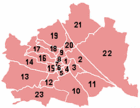
Vienna is the capital, largest city, and one of nine federal states of Austria. Vienna is Austria's most populous city and its primate city, with about two million inhabitants, and its cultural, economic, and political center. It is the fifth-largest city proper by population in the European Union and the largest of all cities on the Danube river by population.

Leopoldstadt is the 2nd municipal district of Vienna in Austria. As of 1 January 2016, there are 103,233 inhabitants over 19.27 km2 (7 sq mi). It is situated in the heart of the city and, together with Brigittenau, forms a large island surrounded by the Danube Canal and, to the north, the Danube. It is named after Leopold I, Holy Roman Emperor. Due to its relatively high percentage of Jewish inhabitants before the Holocaust, Leopoldstadt gained the nickname Mazzesinsel. This context was a significant aspect for the district twinning with the New York City borough Brooklyn in 2007.
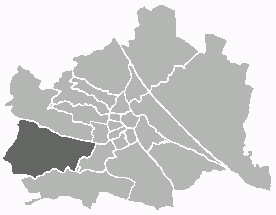
Hietzing is the 13th municipal District of Vienna. It is located west of the central districts, west of Meidling. Hietzing is a heavily populated urban area with many residential buildings, but also contains large areas of the Vienna Woods, along with Schönbrunn Palace.

The Innere Stadt is the 1st municipal district of Vienna located in the center of the Austrian capital. The Innere Stadt is the old town of Vienna. Until the city boundaries were expanded in 1850, the Innere Stadt was congruent with the city of Vienna. Traditionally it was divided into four quarters, which were designated after important town gates: Stubenviertel (northeast), Kärntner Viertel (southeast), Widmerviertel (southwest), Schottenviertel (northwest).

The Gürtel is a substantial beltway of Vienna. Running 13.1 km (8.1 mi) parallel to the famous Vienna Ring Road, it encompasses the inner city districts (Innenbezirke) and follows the route of the former Linienwall outer fortification. The city's red-light district is situated around the Gürtel.
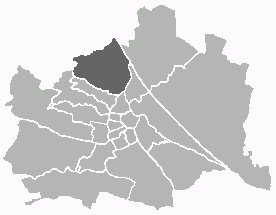
Döbling is the 19th district in the city of Vienna, Austria. It is located in the north of Vienna, north of the districts Alsergrund and Währing. Döbling has some heavily populated urban areas with many residential buildings, and borders the Vienna Woods. It includes some of the most expensive residential areas such as Grinzing, Sievering, and Neustift am Walde, and is home to many Heurigen taverns. There are some large Gemeindebauten, including Vienna's most famous, the Karl-Marx-Hof.

Donaustadt is the 22nd district of Vienna, Austria . Donaustadt is the eastern district of Vienna.
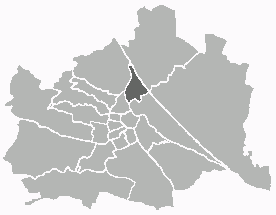
Brigittenau is the 20th district of Vienna. It is located north of the central districts, north of Leopoldstadt on the same island area between the Danube and the Danube Canal. Brigittenau is a heavily populated urban area with many residential buildings.
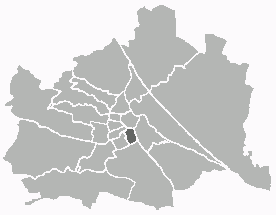
Wieden is the 4th municipal district of Vienna, Austria. It is near the centre of Vienna and was established as a district in 1850, but its borders were changed later. Wieden is a small region near the city centre. After World War II, Wieden was part of the Soviet sector of Vienna for 10 years.

Margareten is the fifth district of Vienna. It is near the old town of Vienna and was established as a district in 1850, but borders changed later. Margareten is a residential urban area, with over 25,000 inhabitants per km2, one of the most densely populated districts in Vienna. The district is named after Margaret of Antioch.

Favoriten, the 10th district of Vienna, Austria, is located south of the central districts. It is south of Innere Stadt, Wieden and Margareten. Favoriten is a heavily populated urban area with many residential buildings, but also large recreational areas and parks.
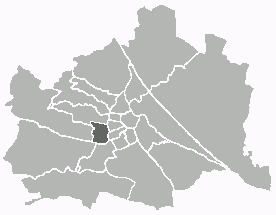
Rudolfsheim-Fünfhaus is the 15th municipal District of Vienna, Austria. It is in central Vienna, west of Innere Stadt.

The Donaukanal is a former arm of the river Danube, now regulated as a water channel, within the city of Vienna, Austria. It is 17.3 kilometres (10.7 mi) long and, unlike the Danube itself, it borders Vienna's city centre, Innere Stadt, where the Wien River (Wienfluss) flows into it.

The Vienna Stadtbahn was a rail-based public transportation system operated under this name from 1898 until 1989. Today, the Vienna U-Bahn lines U4 and U6 and the Vienna S-Bahn run on its former lines.
The Wienzeile is a street in Vienna, which originated in the course of the regulation of the Vienna River between 1899 and 1905 along the river's banks.
The history of the Jews in Vienna, Austria, goes back over eight hundred years. There is evidence of a Jewish presence in Vienna from the 12th century onwards.

The Linienwall was the outer line of the fortifications for the city of Vienna, Austria, that lay between the city’s suburbs and outlying villages. Constructed in 1704, it was razed in 1894 to make way for the Vienna Beltway.
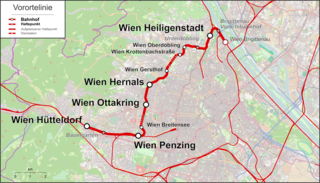
The Suburban line is a railway line in the city of Vienna. It runs approximately 14 kilometres (8.7 mi) from Wien Hütteldorf to Wien Heiligenstadt, running around the northwest side of the city. It hosts the S45 service of the Vienna S-Bahn.

The Augartenbrücke is a bridge that crosses the Donaukanal in Vienna, which connects the 9th district (Alsergrund) and the 1st district on the southwest side of the canal with the 2nd district, Leopoldstadt, on the northeast side. There has been a bridge on the site since 1782.









































